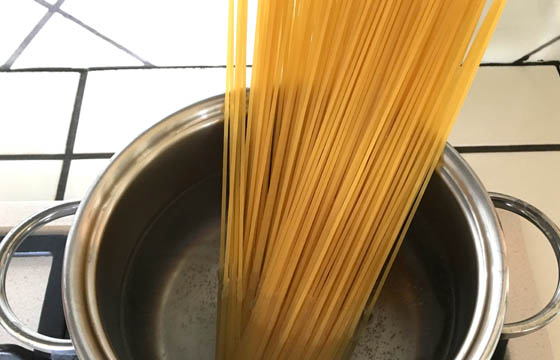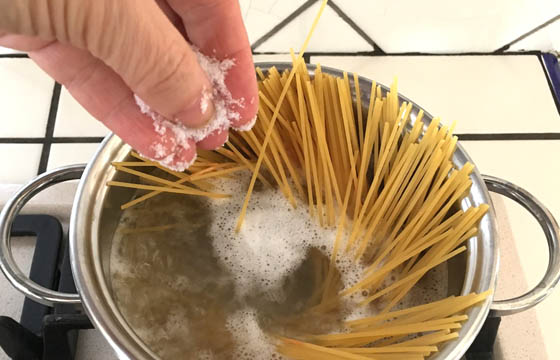Ingredients
 320 g of spaghetti or linguine
320 g of spaghetti or linguine 400 g tomato puree
400 g tomato puree Salt to taste
Salt to taste Grated pecorino cheese to taste
Grated pecorino cheese to taste Pepper to taste
Pepper to taste

When it comes to the history of recipes, it can be said that “all roads lead to Naples”. Before explaining the "Tavernara spaghetti" recipe, we need to try to get to the origins of tomato sauce, a true bastion of the Campania and Italian cuisine. The first sources on the preparation of a tomato sauce are mainly connected to Neapolitan cuisine. Latini was the first to illustrate a recipe, but it was more a boiled tomato salad. In 1773, again in Naples, Vincenzo Corrado published a cookbook containing thirteen recipes based on tomato sauce, which by then had become popular in southern Italy. However, tomato sauce was used to accompany a variety of preparations, not to dress pasta. It was Francesco Leonardi, in an inspired work in six volumes, to make the first mention of tomato sauce dressing pasta. The work Modern Apicious proposes a "meat sauce for maccaroni" with a direct reference to "Neapolitan style maccaroni". In 1807, the volume Homemade cooking ratified this culinary tradition until 1844, when a simpler version of "Italian sauce" with garlic and basil made its appearance. Over the years, Neapolitans have turned tomato sauce into a real cult. In times when everything was scarce, virtue was made of necessity, and August was the time to prepare the tomato preserves for the winter. Imagine life at the foot of Vesuvius, that sleeps kissed by clouds. The noisy alleys with sunny courtyards in August and the chubby ladies sitting at the entrance of palaces on small and rickety stools. All around, tomatoes spread over worn out white linens. The large boiling aluminium pots spread the spicy aroma of cooked tomatoes in the air. The heat is merciless and the sea is far away; all the women in the family work like ants cooking, bottling and re-boiling the tomatoes in large cans stored as a treasure for generations. In September, tomato preserves will be stored and they will gather dust over the entire winter on rusty iron shelves of shaded verandas. With moderation, every Sunday the family will open a couple of them and prepare the sauce, with the frost of winter outside and a summer aroma inside. But this is another story. Then, in the evening, when the jars are all corked, it is time to sample some new tomato pulp to season a spaghetti dish. Only tomato, no oil or garlic. An abundant sprinkle of pecorino cheese and a pinch of pepper, the sweat on the foreheads is now dry and the courtyards have a festive atmosphere. Generation follows generation, the busy women of then have papier-maché hands and time-veiled eyes, the ability to kneel for hours on the blazing gravel is a faded image, but there is still a vivid urgency of narrating the old recipes. Listening, and cooking and remembering. Most of the time, that is the only heritage that they carry with them, but perhaps there is no more precious asset than the knowledge of where we come from. This is the story of every Neapolitan, the story of a people that works hard before enjoying and finds in slowness and patience the strength to cope with hardships. A bit of tomato and a good pasta dish are enough. After all, tomorrow is another day.
 320 g of spaghetti or linguine
320 g of spaghetti or linguine 400 g tomato puree
400 g tomato puree Salt to taste
Salt to taste Grated pecorino cheese to taste
Grated pecorino cheese to taste Pepper to taste
Pepper to taste

Place a pot full of water on the fire. As soon as it starts boiling, add the spaghetti or linguine.

Meanwhile, put the tomato in a saucepan without any other ingredient. Season the tomato according to your taste, taking into account that the pecorino you will add in the end is very salty. As soon as the spaghetti have softened, stir with a fork and pour abundant salt into the cooking water.

When the tomato reaches the boil, turn off the fire. Drain the spaghetti “al dente” and dress them with the tomato sauce, some freshly ground pepper and grated pecorino cheese. If you like it, garnish with a fresh basil leaf.